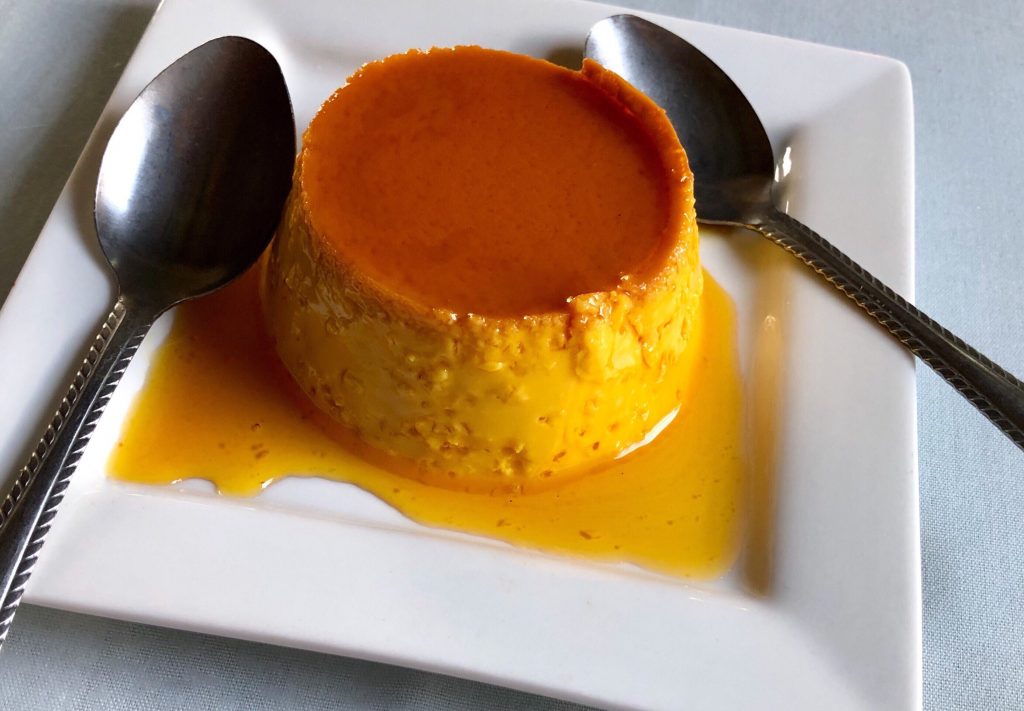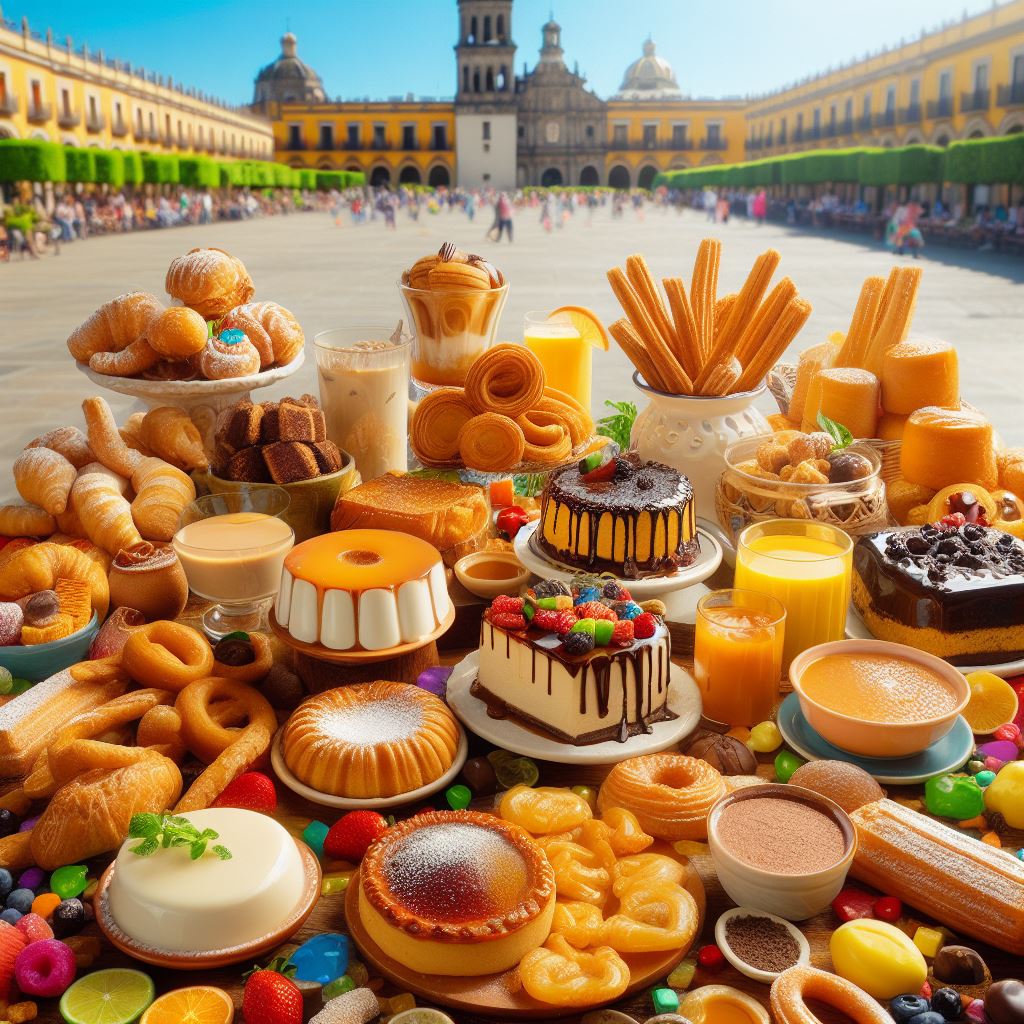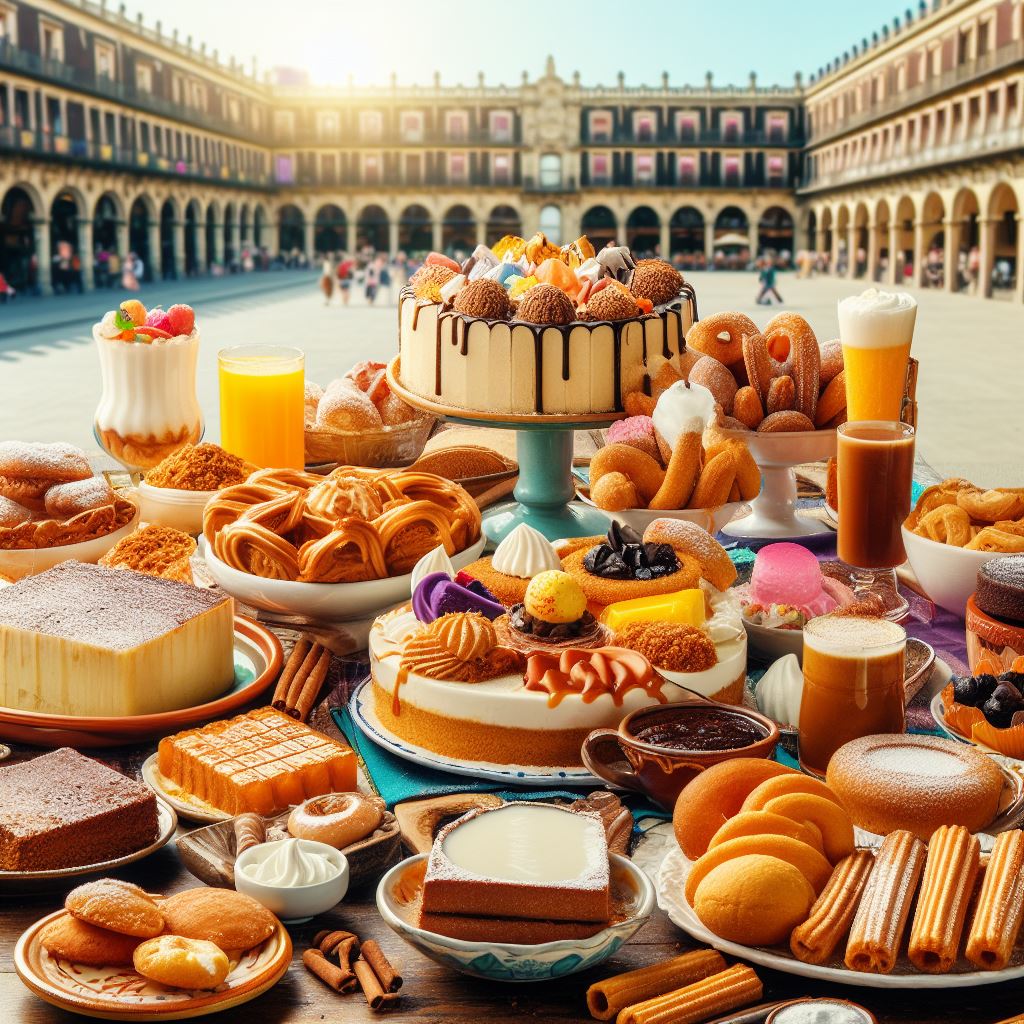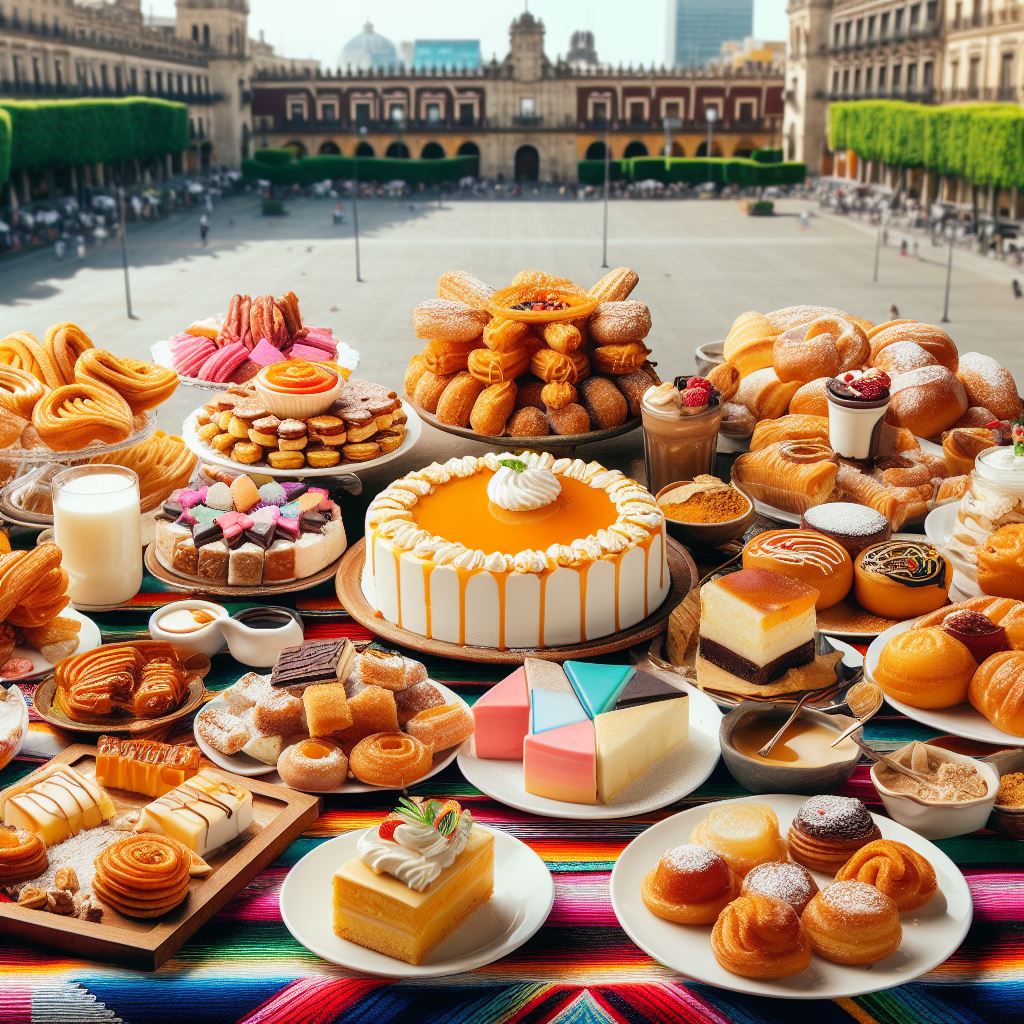Delicious Mexican Desserts That Will Transport You to a Sweet Paradise
Origins of Mexican Desserts
The culinary tapestry of Mexico is vibrant and steeped in history, with each thread representing a myriad of flavors, ingredients, and traditions. The inception of Mexican desserts can be traced back to the pre-Columbian era, where the indigenous people cultivated a rich array of fruits, nuts, and honey, concocting simple yet flavorful delights. The advent of the Spanish colonization in the early 16th century intertwined European ingredients and techniques with indigenous traditions, giving birth to an array of confections that echo the essence of two diverse cultures.
Thank you for reading this post, don't forget to subscribe!
Significance of Desserts in Mexican Cuisine
In the realm of Mexican cuisine, desserts hold a pivotal role, acting as a cultural compass pointing towards the nation’s rich heritage and varied regional influences. These sweet creations are not mere culinary afterthoughts but are integral elements that encapsulate familial bonds, regional diversity, and time-honored traditions. Desserts in Mexican cuisine are synonymous with celebration and are a quintessential component in festivities, religious observances, and familial gatherings, symbolizing joy, unity, and reverence to cultural customs. They are reflections of the geographical diversity of Mexico, each region boasting its distinctive flavors, ingredients, and preparation techniques, thus contributing to the multifaceted personality of Mexican culinary arts.
The Variety of Flavors and Ingredients
Mexican desserts are a vibrant kaleidoscope of flavors and textures, offering a rich palette of sweet experiences. The spectrum of ingredients is vast, with the use of native elements like chilies, corn, and avocados, juxtaposed with introduced elements like dairy, wheat, and sugar from European settlers. The essence of chocolate, a gift from the ancient Aztecs, mingles with the exotic hint of vanilla, offering a tantalizing dance of flavors. Fruits like mango, pineapple, and guava lend their sweet and tangy notes, while the nuanced flavors of spices like cinnamon and anise whisper through the creations, adding layers of complexity and warmth.
The varied landscapes of Mexico, from arid deserts to lush tropical forests, have bestowed a diverse bounty of ingredients, enabling the development of a rich and varied dessert repertoire. The interplay between textures—crispy, creamy, fluffy, and chewy—adds another dimension to the Mexican dessert experience, each bite narrating a story of its origin, tradition, and innovation.
In the embrace of sweetness, where flavors dance and textures play, Mexican desserts weave tales of convergence, tradition, and celebration. They are not merely dishes to conclude a meal but are vibrant expressions of a nation’s history, culture, and culinary creativity. As we delve deeper into the subsequent chapters, we explore the essence of traditional and contemporary desserts, the significance of fruits, and the integration of these sweet marvels in celebrations and easy-to-make formats, allowing us to savor the multifaceted sweetness that Mexican cuisine has to offer.

Chapter 2. Famous Traditional Mexican Desserts
2.1. Tres Leches Cake
2.1.1. Brief Description and Origin
Tres Leches Cake, a cornerstone in the repertoire of Mexican desserts, stands as a testament to the culinary amalgamation witnessed by Mexican cuisine. It’s a rich, moist cake that is steeped in a mixture of three kinds of milk—evaporated, condensed, and whole milk, a triumvirate that gives the dessert its iconic name and distinctive texture. This confection, with its roots potentially stemming from various regions, encapsulates the sweetness and richness inherent in Mexican dessert traditions.
2.1.2. Key Ingredients and Flavor Profile
- Milk Trio: The convergence of evaporated, condensed, and whole milk imparts a luscious moisture and a distinctive creamy flavor to the cake.
- Sponge Cake Base: A light and airy sponge serves as the canvas, absorbing the milky concoction, and delivering a texture that is both dense and delicate.
- Toppings: A myriad of toppings, from whipped cream to fresh fruits or cinnamon, can grace the cake, adding layers of flavor and visual appeal.
2.2. Churros
2.2.1. Brief Description and Origin
The crispy and golden allure of Churros holds a revered place in Mexican culinary heritage. These elongated, fried dough pastries, often associated with Spanish cuisine, found a harmonious adaptation within Mexican gastronomy. Characterized by their ridged surface and dusting of sugar and cinnamon, Churros serve as a sweet rendezvous between crunchiness and warmth, often accompanied by a side of rich chocolate sauce or dulce de leche.
2.2.2. Variations and Serving Suggestions
- Dipping Sauces: A variety of sweet accompaniments such as chocolate sauce, cajeta, or dulce de leche elevate the tasting experience.
- Fillings: Some variations encompass fillings like cream or chocolate, infusing the crispy layers with a contrasting creamy texture.
- Serving Occasion: Whether savored as a breakfast delicacy or a snack, Churros are versatile, complementing various moments of indulgence.
2.3. Flan
2.3.1. Overview and Historical Background
Flan stands as an emblem of creamy and caramel-infused perfection within the pantheon of Mexican desserts. This creamy custard dessert, with its origins likely traced back to ancient Rome, found its way to Mexican tables through Spanish influence, becoming a staple with its smooth texture and enticing caramel topping. The gentle wobble of Flan resonates with the sweet symphony of simplicity and elegance intrinsic to Mexican dessert culture.
2.3.2. Preparation Methods and Flavor Variations
- Caramel Layer: The golden caramel layer crowning the custard adds a sweet and slightly bitter contrast, enhancing the overall flavor palette.
- Custard Base: The silky amalgamation of eggs, milk, and sugar forms the foundation, offering a melt-in-the-mouth experience.
- Flavor Infusions: The infusion of flavors like vanilla, coffee, or citrus adds nuanced dimensions, broadening the culinary landscape of this classic dessert.
2.4. Arroz Con Leche
2.4.1. Description and Cultural Significance
Arroz Con Leche, translating to rice with milk, is a sweet concoction marrying the simplicity of rice with the creamy richness of milk. This comforting dessert, reminiscent of the global appeal of rice puddings, emanates warmth and homeliness, symbolizing the embrace of familial bonds and shared meals. Its ubiquity in Mexican households marks it as a dish that traverses the boundaries of everyday indulgence and festive celebrations.
2.4.2. Popular Recipes and Variations
- Base Ingredients: The unison of rice, milk, and sugar forms the foundational delight, rendering a creamy and comforting texture.
- Spice Infusion: The whisper of cinnamon and a hint of vanilla weave through the creamy grains, adding aromatic warmth and subtle sweetness.
- Garnishes: A sprinkle of raisins or a zest of lime can adorn the dish, contributing additional flavors and textures to the wholesome ensemble.
In the journey through traditional Mexican desserts, each dish tells a story of historical intersections, cultural adaptability, and culinary innovation. The myriad of flavors, textures, and preparation techniques depict the richness and diversity of Mexican gastronomy, with each dessert holding a mirror to the culinary tapestry of the nation. The legacy of these traditional sweet marvels continues to captivate palates, weaving the essence of Mexican heritage into every bite.
Chapter 3. Contemporary Takes on Mexican Desserts

3.1. Mexican Chocolate Cheesecake
The culinary landscape of Mexico is ever-evolving, and a testament to this dynamism is the Mexican Chocolate Cheesecake. This dessert blends the rich, robust flavors of Mexican chocolate with the creamy, velvety texture of cheesecake, resulting in a gastronomic experience that tantalizes the taste buds.
3.1.1. Description and Modern Adaptations
Mexican Chocolate Cheesecake is not a traditional dessert but rather a modern invention that represents the amalgamation of diverse culinary cultures. The bold flavors of Mexican chocolate—characterized by its granular texture and hints of cinnamon and sometimes chilies—are perfectly balanced with the smooth and rich texture of cheesecake.
In recent years, chefs and home bakers alike have experimented with various adaptations, incorporating ingredients such as cajeta (a type of milk caramel) and introducing layers of different textures, contributing to the dessert’s burgeoning popularity. These adaptations not only pay homage to Mexican culinary traditions but also cater to the contemporary palate, seeking a fusion of flavors and textures.
3.1.2. How It Differs from Traditional Desserts
The fusion inherent in the Mexican Chocolate Cheesecake sets it apart from more traditional Mexican desserts. While traditional desserts often emphasize singular, standout flavors and textures, this contemporary creation embraces a multifaceted flavor profile, bringing together the spiciness, sweetness, creaminess, and crunchiness in each bite.
3.2. Sopapilla Cheesecake
Another innovative addition to the realm of Mexican desserts is the Sopapilla Cheesecake, which combines the flakiness of sopapilla, a kind of deep-fried pastry, with the richness of cheesecake.
3.2.1. Brief Overview and Popularity
Sopapilla Cheesecake is renowned for its simplicity and delightful texture. This dessert has quickly gained popularity owing to its straightforward preparation process and the harmonious interplay between the crispy sopapilla and the creamy cheesecake. It is frequently adorned with a drizzle of honey or a dusting of cinnamon sugar, enhancing its appeal to those with a sweet tooth.
3.2.2. Unique Ingredients and Serving Occasions
The dessert is often associated with celebratory events and casual gatherings, served as a sweet conclusion to festive meals. The incorporation of cream cheese adds a velvety richness to the dish, while the sopapilla layer offers a crispy contrast, making it a favorite amongst those who crave varied textures in desserts.
3.3. ChocoFlan
ChocoFlan, also known as “Impossible Cake,” is a marvel in the dessert world, featuring a layer of chocolate cake and a layer of flan. This dessert exemplifies the creative spirit of modern Mexican cuisine.
3.3.1. Background and Emergence
The inception of ChocoFlan can be traced back to culinary experimentations aiming to combine contrasting textures and flavors in one dish. The moist decadence of chocolate cake marries the creamy, caramel-infused texture of flan, creating a dual experience of indulgence. Its layered presentation is visually striking, contributing to its acclaim in contemporary dessert offerings.
3.3.2. Flavor Combinations and Recipe Variations
The journey of flavors in ChocoFlan starts with the rich, dense chocolate at the base and concludes with the smooth, vanilla-infused flan on top. Variations of this dessert have emerged, with some incorporating coconut, nuts, or fruit, each adding a distinctive twist to the original recipe. The adaptability of ChocoFlan enables it to cater to a plethora of palates, reinforcing its status as a cherished dessert in modern Mexican cuisine.
In conclusion, the contemporary takes on Mexican desserts signify the evolution of Mexican culinary arts. The innovations and adaptations in desserts like Mexican Chocolate Cheesecake, Sopapilla Cheesecake, and ChocoFlan reflect the shifting tastes and the amalgamation of diverse culinary influences. These desserts, with their multifaceted flavor profiles and distinctive textures, not only preserve the essence of Mexican cuisine but also embrace modernity, offering a renewed and enriched gastronomic experience.
Chapter 4. The Role of Fruits in Mexican Desserts
4.1. Mangonada Sorbet
4.1.1. Overview and Use of Mango
Mangonada Sorbet is a refreshing and flavorful Mexican dessert that has gained popularity for its unique blend of sweetness, spiciness, and tartness. The primary fruit utilized in this dessert is the mango, chosen for its juicy and aromatic qualities, elevating the overall sensory experience of the dessert. Mango’s richness and versatility make it an ideal candidate, allowing it to blend seamlessly with various ingredients and spices, including chili powder and lime, creating a harmonious dance of flavors on the palate.
4.1.2. Complementing Ingredients and Taste
To enhance the flavor profile of Mangonada Sorbet, tamarind and chamoy are often integrated, providing layers of complexity to the dessert. The sweet and sour notes of tamarind juxtaposed with the savory taste of chamoy create a well-rounded and sophisticated flavor experience. The addition of chili powder provides a subtle heat, heightening the boldness of the mango and adding an exciting twist to the sorbet.
4.2. Fresas Con Crema
4.2.1. Strawberry Utilization and Appeal
Fresas Con Crema is another remarkable dessert, where strawberries are the star, immersed in a lush, sweet cream. The inherent sweetness and acidity of strawberries make them a beloved fruit in Mexican dessert cuisine, bringing freshness and vibrancy to the dish. This dessert exemplifies simplicity yet is profound in its flavor delivery, showcasing the beauty of utilizing fresh, high-quality ingredients.
4.2.2. Preparation Methods and Recipe Adjustments
To prepare Fresas Con Crema, the strawberries are typically sliced and mixed with a sweetened cream mixture, often consisting of condensed milk and sour cream. The balance between the sweetness of the cream and the tanginess of the strawberries results in a harmonious and indulgent dessert. This versatile dish allows for various adjustments, such as incorporating different fruits or altering the cream’s sweetness level, catering to a wide array of palates.
4.3. Mexican Fruit Cake
4.3.1. Incorporation of Various Fruits
Mexican Fruit Cake is a testament to the versatility and richness of incorporating different fruits in Mexican desserts. This cake is often adorned with a medley of fruits such as pineapple, kiwi, and berries, each contributing its distinct flavor, texture, and color to the dessert. The amalgamation of these fruits not only enhances the visual appeal of the cake but also adds layers of flavor, making each bite a unique experience.
4.3.2. Celebratory Significance and Variations
Mexican Fruit Cake is often associated with celebrations and gatherings, symbolizing joy and unity. The cake’s festive appearance and delightful taste make it a popular choice for various occasions. While the traditional recipe is revered, many variations exist, allowing for the incorporation of different fruits, cake bases, and creams to suit individual preferences and dietary needs. Such adaptability ensures the continued evolution and enjoyment of this cherished dessert.
4.4. Conclusion
The incorporation of fruits in Mexican desserts adds a dimension of freshness, vibrancy, and complexity to the culinary creations. Whether it’s the boldness of mango in Mangonada Sorbet, the sweet simplicity of strawberries in Fresas Con Crema, or the diverse fruit medley in Mexican Fruit Cake, each fruit plays a pivotal role in enhancing the dessert’s overall flavor profile and appeal. These fruit-based desserts, with their varied textures, flavors, and appearances, encapsulate the essence of Mexican culinary artistry, offering a myriad of sensory delights to dessert aficionados around the world.

Chapter 5. Mexican Desserts for Special Occasions
Mexican desserts hold a pivotal role during special occasions, acting as a sweet embodiment of Mexico’s rich culinary heritage and cultural traditions. This chapter delves into the profound significance and inherent charm of these desserts, bringing a sense of completion and celebratory joy to various occasions. The focus will be on Mexican Wedding Cookies, Capirotada, and Day of the Dead Bread, examining their cultural implications, preparations, and unique characteristics.
5.1. Mexican Wedding Cookies
5.1.1. Significance in Weddings and Celebrations
Mexican Wedding Cookies, also known by various other names such as biscochitos, are a symbol of joy and unity at weddings and other celebrations. They are traditionally served as a gesture of love and happiness, enveloping guests in the sweet essence of the celebration. The melt-in-your-mouth texture and delicate sweetness of these cookies make them a highly sought-after treat, transcending the boundaries of the event they represent.
5.1.2. Key Ingredients and Alternative Names
Primarily composed of flour, butter, powdered sugar, and nuts, these cookies are simple yet immensely flavorful. The incorporation of nuts, typically pecans or almonds, bestows a subtle, nutty undertone to the cookies. After baking, a generous dusting of powdered sugar adds a delightful sweetness, enhancing the overall taste experience.
While widely recognized as Mexican Wedding Cookies, these delightful confections are also known as Russian tea cakes or snowball cookies, illustrating their widespread appeal and versatile nature.
5.2. Capirotada
5.2.1. Religious Significance and Observance
Capirotada, a traditional Mexican bread pudding, holds immense religious significance, especially during the Lenten season. It’s a quintessential dish during this time, representing the suffering of Christ with its layered composition, symbolizing the Cross and the Crown of Thorns. The layers of bread soaked in a rich syrup interspersed with a variety of ingredients createa medley of flavors, reflecting the diversity and depth of Mexican culinary arts.
5.2.2. Preparation Techniques and Serving Traditions
The preparation of Capirotada involves soaking pieces of bread in a syrup made from piloncillo (unrefined cane sugar) and spices, creating a foundation of sweet, spicy richness. The inclusion of ingredients like cheese, peanuts, and raisins adds diverse textures and flavors, allowing for a harmonious balance between sweet and savory.
Typically, Capirotada is served warm, allowing the melding of flavors to shine, creating a comforting and fulfilling experience, symbolizing communal unity and spiritual reflection during religious observances.
5.3. Day of the Dead Bread (Pan de Muerto)
5.3.1. Cultural Importance and Symbolism
Pan de Muerto, or the Bread of the Dead, is deeply intertwined with the Mexican tradition of Día de los Muertos, a time for honoring and remembering the deceased loved ones. The bread is a symbolic offering, featuring on altars dedicated to the departed, acting as a token of love and remembrance. It embodies the essence of this tradition, symbolizing the cycle of life and death with its circular shape and intricate decorations representing bones.
5.3.2. Traditional Recipe and Modern Twists
Creating Pan de Muerto involves a meticulous process, incorporating ingredients like orange blossom water and anise seeds, rendering a unique flavor profile resonant of Mexican heritage. The bread is usually adorned with bone-shaped pieces of dough and sprinkled with sugar, accentuating its symbolic and sensory appeal.
Modern interpretations of this revered bread have emerged, incorporating innovative ingredients and techniques, expanding its culinary dimensions while respecting its cultural and symbolic roots.
Summary
Mexican desserts like Mexican Wedding Cookies, Capirotada, and Pan de Muerto are more than just confectionery delights. They are steeped in tradition, symbolizing love, unity, remembrance, and spirituality, serving as culinary reflections of Mexico’s rich cultural tapestry. Each dessert, with its unique flavors, textures, and symbolic nuances, accentuates the celebratory essence and profound meanings inherent in various special occasions, fortifying their place in the heart of Mexican culinary heritage.
Chapter 6. Easy-to-Make Mexican Desserts
The intricate tapestry of Mexican desserts showcases not only elaborate and ceremonious concoctions but also simpler, delightful recipes. In the hustle and bustle of daily life, having access to quick and easy recipes enables dessert enthusiasts to immerse in the Mexican culinary scene without spending extensive time in the kitchen. This chapter unravels the enticing world of effortless Mexican desserts that are not only delicious but also encapsulate the vibrant essence of Mexican culture.
6.1. Sopapilla Cheesecake Bars
6.1.1. Simplicity and Preparation Time
Sopapilla Cheesecake Bars signify the brilliance of combining simplicity with flavor. This dessert emerges as a seamless amalgamation of the crispy, honey-drizzled sopapilla and the smooth, creamy texture of cheesecake. Requiring minimal ingredients such as crescent roll dough, cream cheese, sugar, and cinnamon, it promises a hassle-free preparation process, making it a favorite for those seeking to whip up a quick dessert. A mere thirty minutes is all it takes to prepare this dish, allowing the luxury of indulging in a sweet delight without a prolonged wait.
6.1.2. Adaptations and Recipe Modifications
Given the simplistic nature of Sopapilla Cheesecake Bars, modifications and adaptations abound. The introduction of diverse flavor elements, such as chocolate drizzle or fresh fruits, enhances the overall taste and presentation. Additionally, opting for a gluten-free or low-sugar variant caters to the diverse dietary needs and preferences of the culinary aficionados.
6.2. Quick Mexican Brownies
6.2.1. Incorporating Mexican Flavors
Quick Mexican Brownies showcase a harmonious blend of rich chocolate and distinct Mexican spices. The incorporation of cinnamon and a hint of cayenne pepper elevates the conventional brownie experience, offering a spicy kick that complements the sweet, chocolaty richness. These brownies not only provide a symphony of flavors but also ensure a speedy preparation process, ideal for satiating those sudden dessertcravings.
6.2.2. Tips for a Perfect Batch
Achieving the perfect batch of Mexican brownies entails a balanced amalgamation of flavors and textures. The use of high-quality cocoa powder is pivotal in delivering the desired chocolaty essence. Monitoring the baking time is crucial to avoid overbaking and ensuring the desired fudgy texture. Additionally, allowing the brownies to cool completely before slicing aids in attaining the perfect, delectable pieces.
6.3. Easy Tres Leches Cake
6.3.1. Streamlined Process and Ingredients
The Easy Tres Leches Cake stands as a testament to the convenience of creating indulgent desserts with ease. This moist and flavorful cake, bathed in a blend of three kinds of milk, provides a sweet retreat without an elaborate baking ordeal. The streamlined process involves basic baking ingredients and a combination of condensed, evaporated, and whole milk, presenting a straightforward approach to experiencing this traditional delight.
6.3.2. Serving Suggestions and Add-ons
To elevate the Easy Tres Leches Cake, a plethora of serving suggestions and add-ons exist. A dollop of whipped cream, a sprinkle ofcinnamon, or a garnish of fresh fruits can amplify the aesthetic appeal and flavor profile of this dessert. For a tropical twist, incorporating coconut milk and decorating with toasted coconut flakes can provide a refreshing variation to this classic dessert.
Conclusion: A Symphony of Flavors in No Time
Easy-to-make Mexican desserts offer a delightful escape into the world of sweet indulgence, allowing a quick and convenient exploration of diverse flavors and textures. These recipes bring forth the essence of Mexican culinary artistry, bridging the gap between time constraints and the desire to indulge in flavorful experiences. Whether it’s the creamy and crispy Sopapilla Cheesecake Bars, the spicy and sweet Mexican Brownies, or the moist and milky Tres Leches Cake, these quick recipes grant a taste of Mexican dessert tradition in the comfort of one’s kitchen, reflecting the adaptability and versatility of Mexican cuisine.

Chapter 7. Conclusion
7.1. The Richness of Mexican Dessert Cuisine
Mexican dessert cuisine is an extensive canvas painted with the vibrant hues of its diverse ingredients and profound historical influences. It’s a harmonic symphony of flavors where each dessert tells a unique story, laden with cultural significances and rich traditions. From the aromatic sweetness of Tres Leches Cake to the sophisticated savoriness of flan, each bite is a mosaic of ancient practices, colonial influences, and innovative culinary adaptations.
7.2. Fusion and Evolution of Desserts
The journey of Mexican desserts is a continual dance of evolution and fusion, showcasing a delicate balance between holding onto revered traditions and embracing the allure of novel culinary expressions. The integration of foreign elements and techniques has enriched the Mexican dessert repertoire, giving birth to contemporary creations like Mexican Chocolate Cheesecake and Sopapilla Cheesecake, which not only pay homage to their roots but also tantalize the modern palate with their innovative twists. The intermingling of flavors, techniques, and ingredients from different cultures has been a pivotal factor in sculpting the multifaceted personality of Mexican desserts, rendering them as versatile as they are flavorful.
Culinary Evolution
The culinary tapestry of Mexico has been continually woven with threads of innovation, infusing traditional recipes with fresh perspectives and diverse influences. The quintessential Mexican desserts have undergone numerous transformations, both subtle and profound, catalyzed by the incessant pursuit of culinary excellence and the ever-evolving consumer palate. The constant exploration and experimentation have enabled chefs and home cooks alike to bring forth new dimensions of taste, texture, and aroma within the revered confines of traditional Mexican desserts.
Fusion Artistry
Fusion in Mexican desserts is a creative expression of culinary artistry, a celebration of diversity, and a journey of flavor discovery. It is a meticulous craft that seamlessly blends the essence of varied culinary landscapes, creating harmonious symphonies of taste that are rich, innovative, and soul-satisfying. Fusion brings forth a myriad of possibilities, allowing the time-honored Mexican desserts to transcend their traditional boundaries and embrace the infinite culinary horizons, offering a gastronomic experience that is both familiar and exhilaratingly new.
7.3. Experimenting with Traditional Recipes
The essence of Mexican desserts lies in their ability to encapsulate centuries-old traditions while providing a fertile ground for culinary experimentation. It’s this dynamic interplay between the enduring and the evolving that keeps the spirit of Mexican dessert cuisine alive and flourishing.
Recipe Experimentation
The experimentation with traditional recipes is not merely a culinary endeavor but a cultural evolution, a means to honor the past while exploring the uncharted territories of flavor and texture. It offers a spectrum of possibilities, from subtle tweaks in ingredients to radical reinterpretations, enabling the creation of desserts that resonate with the contemporary palate while echoing the culinary wisdom of the ancestors. The myriad of variations and adaptations underscore the versatility and the boundless potential inherent in Mexican desserts, reflecting the evolving tastes and preferences of the global consumer.
Culinary Creativity
Culinary creativity in Mexican desserts is a boundless realm where tradition meets innovation. It’s a gastronomic canvas where each stroke of creativity adds a new layer of flavor, a different texture, and a unique personality to the dish. The confluence of traditional wisdom and modern inspirations gives rise to a plethora of desserts that are authentic in essence and avant-garde in presentation. This amalgamation of the old and the new ensures that Mexican desserts continue to be a source of joy, a culinary treasure, and a timeless symbol of Mexico’s rich cultural tapestry.
Embracing the Legacy
In conclusion, Mexican desserts are not just a feast for the palate but a journey through the rich tapestry of Mexico’s culinary heritage. They are narratives steeped in history, flavored with diversity, and garnished with innovation. The enduring allure of these desserts is a testament to their timeless appeal, their ability to adapt, and their unwavering position as the sweet ambassadors of Mexican cuisine to the world. Embracing the legacy of Mexican desserts is embracing a world where every flavor tells a story, and every story is a blend of tradition, love, and innovation.

